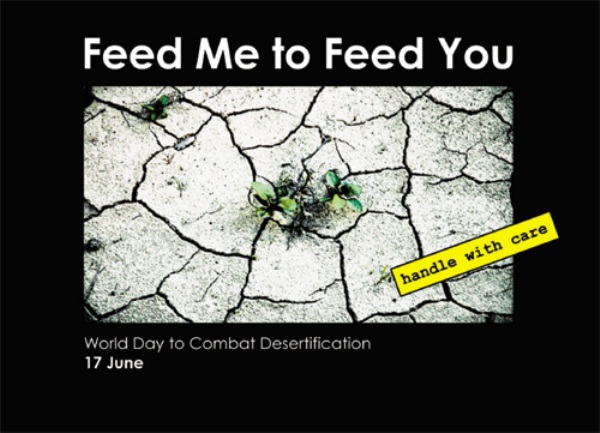[ad#ad-2]
Theme for 2008
Combating land degradation for sustainable agriculture
Credits : UNEP, UNCCD and green hopes.
The 2008 World Day to Combat Desertification is celebrated under the theme, “Combating land degradation for sustainable agriculture.” The issue is a real challenge in the modern society, both in developed and developing countries, as land degradation cannot be solved by the effort of one country alone due to the increasing concern on climate change.

Land degradation intensifies agricultural economic losses, disorganizes local and regional food markets, and causes social and political instability. Here are some basic facts about the linkage between land degradation and sustainable agriculture.
Message of UN Secretary General Ban Ki Moon
THE SECRETARY-GENERAL
MESSAGE ON THE WORLD DAY
TO COMBAT DESERTIFICATION AND DROUGHT
17 June 2008
The theme of this year’s Day, “Combating land degradation for sustainable agriculture” reminds us of the importance of land as a global heritage which no human being can live without. Land degradation affects a significant portion of the Earth’s arable lands, directly impacting the well-being of people and economic development of countries. It causes agricultural economic losses, disorganizes local and regional food markets, and causes social and political instability.
As the population grows, and with it the demand for agriculture production, traditional systems of managing the land are collapsing. This is aggravated by the adoption of new practices, often monocultures. More and more of the good land is pressed into service, without proper attention to conservation, and poor farmers and pastoralists are forced onto marginal land. Land degradation impacts women particularly hard, since traditionally they devote time and effort to the land — growing, processing, managing and marketing most of the food and other natural resources.
These issues are holistically covered within the framework of the United Nations Convention to Combat Desertification, which serves as the nexus between poverty reduction and ecosystem protection in the drylands. Today, the Convention is the sole international legal framework to reclaim dry and degraded land, and could offer a long-term solution to producing more food for more people. These unused lands could also serve for biofuel production, and thus offer new benefits for their inhabitants.
The time has come for the international community to recognize that drylands and marginal lands, where nearly half of the world’s poor live, are not waste land. Rather, they are potential areas for agricultural intensification for both food and energy needs. Let us renew our commitment to reversing land degradation and desertification. Let us ensure that the 10-year strategy adopted last year in Madrid is fully supported and implemented. On this World Day to Combat Desertification and Drought, let us rededicate ourselves to this mission.
————————————————————————————-
What is sustainable agriculture?
Sustainable agriculture refers to the ability of a farm to produce food, without causing irreversible damage to the ecosystem services. The issue is two-fold. One aspect is biophysical that relates to the long-term effects of various practices on soil properties and processes essential for crop productivity. The other is socio-economic that relates to the long-term ability of farmers to obtain inputs and manage resources such as labour.
Over the years, agriculture has changed dramatically due to new technologies, mechanization, increased chemical use, specialization and government policies that favored maximizing production. These changes have had significant costs such as, among others, topsoil depletion, groundwater contamination and the disintegration of economic and social conditions in rural communities. A growing movement has emerged during the past two decades to question the role of the agricultural establishment in promoting practices, which contribute to these environmental and social problems. Today, this movement for sustainable agriculture integrates three main goals–environmental health, economic profitability, social and economic equity, and is gaining increasing support and acceptance within mainstream agriculture. People in different capacities, from farmers to consumers, have shared this vision and contributed to them. Not only does sustainable agriculture address many environmental and social concerns, but also it offers innovative and economically viable opportunities for growers, labourers, consumers, policymakers and many others in the entire food production and consumption system.
Consequence ON LAND DEGRADATION of unsustainable agriculture
Unsustainable agriculture has direct and strong impact on the soil to the point that it cannot regenerate naturally. Soil nutrients and organic matter begin to diminish as intensive agriculture removes quantities of nutrients greater than the soil’s natural regeneration capacities. As a consequence, the soil is unable to recover, as it does during fallow periods, resulting an ever-increasing spiral of land degradation and desertification.
The principal causes exacerbating land degradation derives from the farmers’ determination to maximize soil productivity, which include: crops cultivated in areas at high risk from drought; shortening of crop cycles and the reduction of fallow periods; insufficient use of fertilizer after harvesting; inadequate crop rotation or worse, monoculture; intensive labour; intense breeding and overgrazing with pressure on vegetation and soil trampling by livestock; separation of cattle rearing and agriculture, eliminating a source of natural fertilizer or organic matter used to regenerate the soil; deforestation; bush and forest fires; in mountainous regions, crops are cultivated along the downward sloping face rather than following the natural contour lines of the mountain; deterioration of terraces and other soil and water conservation techniques.
To combat land degradation and desertification, it is necessary to restore and fertilize the land. Nutritive elements such as nitrogen, phosphorus, calcium, magnesium in the soil are necessary for plants to grow. When the soil has lost all its nutritive elements or a part of its constituents (removed by wind or water) it is said to be degraded or exhausted and its productivity diminishes as a consequence.
The way forward TO COMBAT LAND DEGRADATION
Sustainable agriculture is a unique way to maintain and re-establish soil fertility either by using adequate fertilizers or by preparing much adapted compost. It is principally prepared from plant waste: manure, agricultural trimmings (straw), and biological household waste. Water hyacinths, though harmful in rivers, can be transformed into fertile matter that supplies nutritive elements to the soil as compost. After several weeks in a pit, and with the heat and humidity, humus is produced. It can then be spread among the crops and used to prepare the soil before seedlings are planted. The soil regenerated with organic matter in this way will produce more fruitful harvests. The restructuring of the soil is a very effective and particularly sustainable way to maintain soil fertility. The presence of livestock could also be exploited to enrich the soil. By consuming crop leftovers (millet, maize) the animals return nutritive elements to the soil that enriches it with nitrogenous matter in the form of dung, which restores the capacity of soil to produce a more plentiful harvest. The herd also provides meat and milk. In this way, farmers and cattle rearers can help each other.
Several countries around the world have taken important steps towards sustainable agriculture in recent years. In the economic dimension, efforts have been focused on adjusting profitability and productivity of farms, maintaining, developing or rediscovering organic agriculture, on seeking safer and better living conditions for farmers and their families and the rural population in general. In the environment dimension, efforts have mainly been directed towards the sustainable use, management and protection of natural and genetic resources, including the conservation of biodiversity as well as the maintenance and improvement of soil, air and water quality. In the social dimension, recent activities have focused on improving quality of life in rural areas, diversifying economic and employment opportunities, better training and education, and integrating grass-root contributions to rural development.
The UNCCD is providing a universal legal policy and advocacy framework for its 193 Parties to combat desertification and land degradation. In implementing the Convention, the great leverage has been made through the unique participatory process of local stakeholders, including farmers and rural populations that offer a number of possibilities to illustrate. In addition, capacity building, sharing of best practices and case studies, partnership development and awareness raising are some of the areas to be refocused under the newly adopted Ten-year strategic plan and framework to enhance the implementation of the Convention (2008-2018). The UNCCD supports member Parties to combat land degradation for sustainable agriculture as the way for future.
FOOD INSECURITY IN KASHMIR
What is happening in Kashmir ?


It is easy to talk of sustainable agriculture than practicing. Our farmers can do that as they were doing for centuries provided they get good prize for their produce. In addition the market is dominated by mediators with politicians in their hand. There is no marketting system in india. The farmers cannot fix the prize for their products. Two months back karnataka govt has slaughtered thousands of large trees , some of them 300-400 yrs old prabably planted during Tippu sultan/maharajas of erstwhile mysore state. A large banyan tree provides atleast 100 birds at any time of the day. Imagine the number of birds and other small animals becoming shelterless from bangalore to Hassan the only segment which I came across. The govt could not recognise this. Not even a single tree is planted so far. The govt is busy in aquiring the farmers land for SEZs there by discouraging farming.
* Make the authorities accountable.
* Let the farmers fix the prize for their products.
* Provide low interest loans to the farmers instead waving off loans.
Thnks for posting
well done, dude